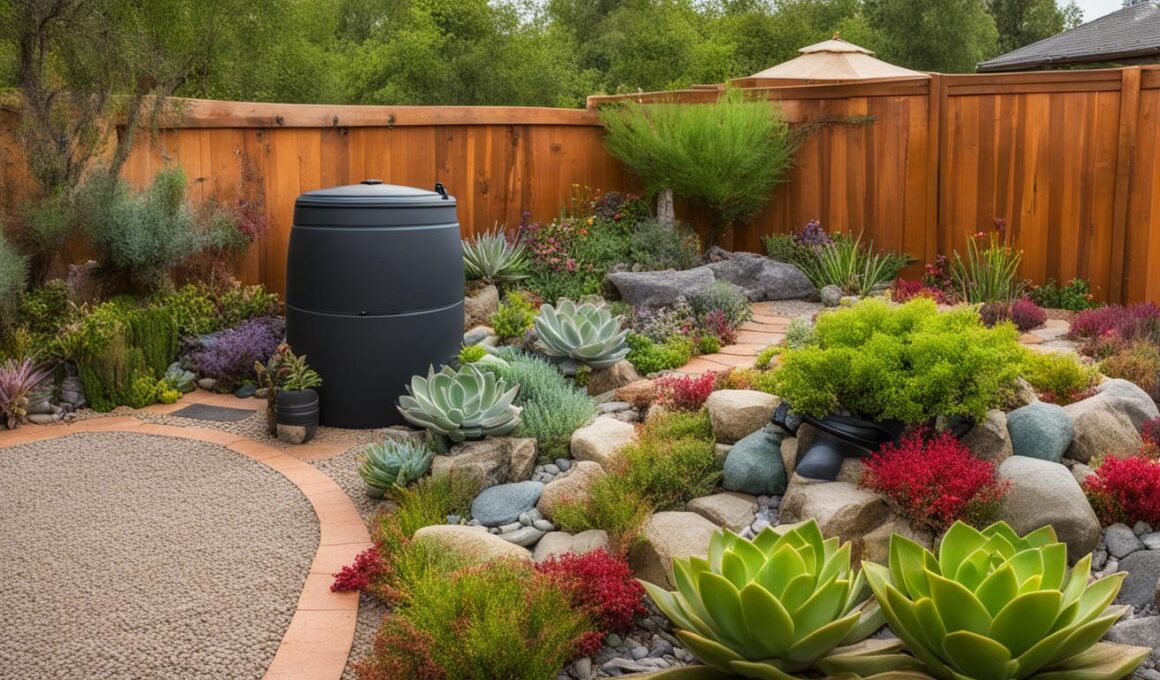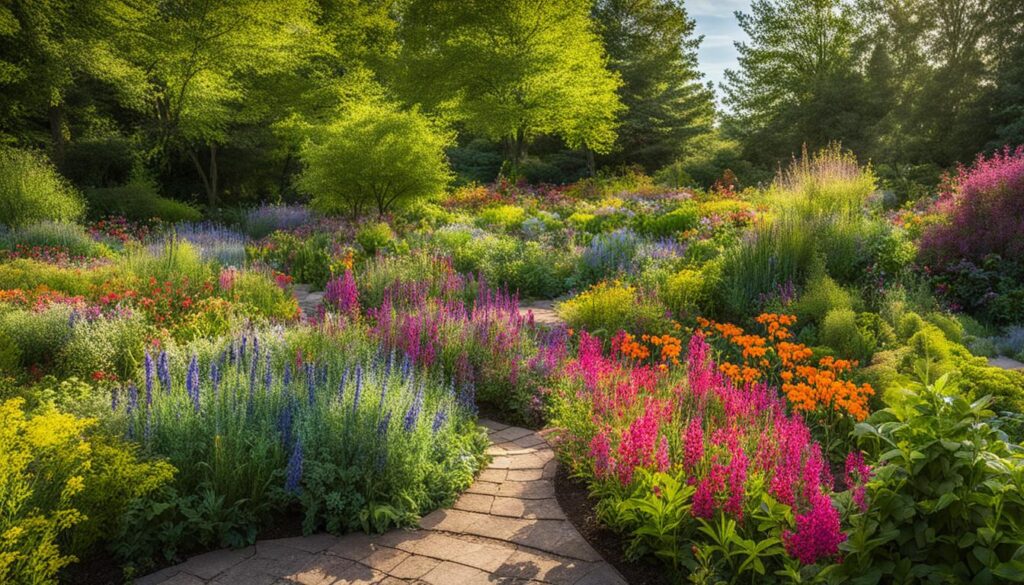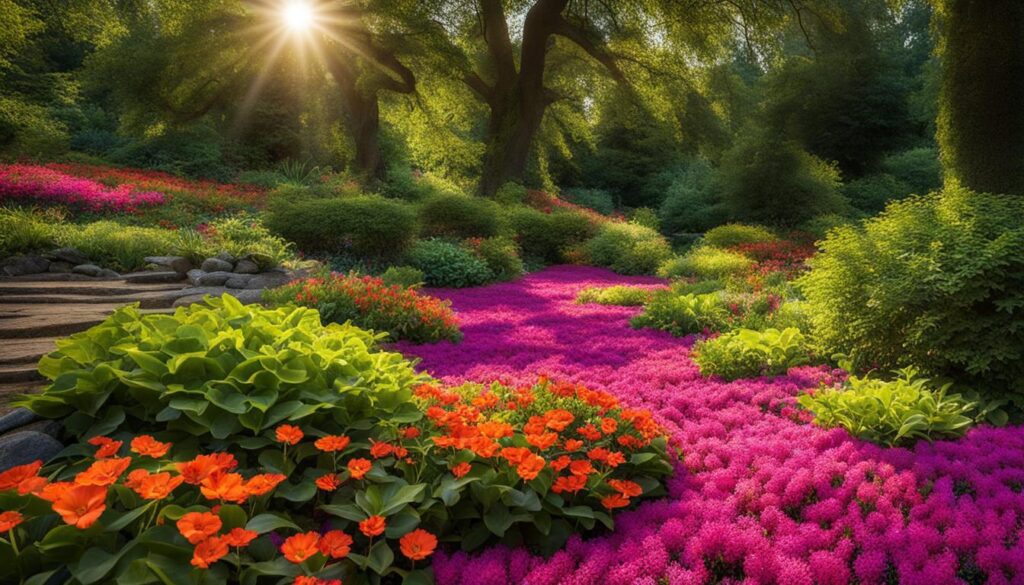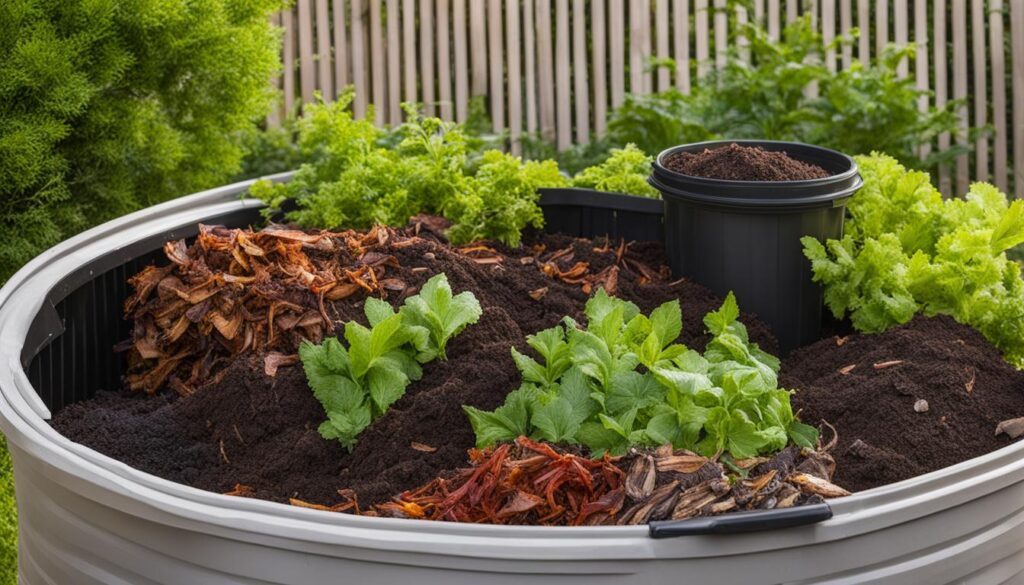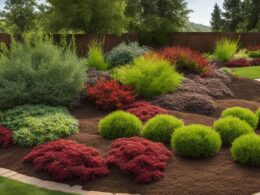Incorporating eco-friendly design and maintenance into your landscaping can provide a beautiful and inviting yard that is simple to maintain while also helping to save the environment. Choosing native plants, using organic mulch, and planting ground cover instead of grass are among the top eco-friendly xeriscape upkeep practices. These practices save water, reduce the need for fertilizers and pesticides, and create a habitat for local wildlife. By following these 10 tips, you can transform your garden into a verdant, water-saving oasis.
Key Takeaways:
- Choosing native plants is beneficial for local wildlife and reduces the need for maintenance.
- Using organic mulch helps retain moisture and suppresses weed growth.
- Planting ground cover instead of grass requires less watering and maintenance.
- Maintain grass height and start composting for a healthier lawn.
- Eco-friendly landscaping practices save time, effort, and contribute to a greener world.
Choose Native Plants
When it comes to creating an eco-friendly xeriscape, selecting native plants is a key step. Native plants are species that naturally occur in your region, making them well-suited to the local climate and soil conditions. By choosing native plants for your yard, you not only enhance the beauty of your landscape, but also support the local ecosystem.
One of the main advantages of native plants is their ability to attract local wildlife. Birds, butterflies, and other beneficial creatures rely on native plants for food and shelter. By creating a habitat with a variety of native plants, you provide a safe haven for these species, contributing to their conservation.
Another benefit of native plants is their easy maintenance. Since they are adapted to the local environment, they require less water, fertilizer, and pesticide compared to non-native species. Native plants are naturally resistant to pests and diseases, reducing the need for chemical interventions. With minimal effort, you can enjoy a vibrant and thriving landscape.
Create a Native Plant Garden
To incorporate native plants into your xeriscape, start by researching the native flora of your area. Look for plants that are well-suited to your specific conditions, such as sun exposure, soil type, and moisture levels. You can visit local nurseries or consult gardening experts for advice on native plant selections.
Native plants provide habitat and attract birds, butterflies, and other beneficial local wildlife.
Once you have chosen your native plants, arrange them strategically in your garden to create an aesthetically pleasing design. Consider grouping plants with similar water and sunlight requirements together. This not only simplifies maintenance but also maximizes water efficiency.
By choosing native plants for your xeriscape, you can enjoy a beautiful and environmentally-friendly landscape that supports local wildlife and requires minimal maintenance.
Use Organic Mulch
When it comes to maintaining an eco-friendly xeriscape, using organic mulch is a key practice to consider. Organic mulch, such as wood chips, bark, leaves, and pine needles, offers numerous benefits for your landscaping. One of the main advantages is moisture retention. By applying a layer of organic mulch around your plants and garden beds, you create a barrier that helps to lock in moisture, reducing the need for frequent watering.
Furthermore, organic mulch acts as a natural weed suppressant. It helps to smother weeds and prevent their growth, saving you time and effort in weed control. Additionally, as the organic mulch breaks down over time, it adds nutrients to the soil, enriching it and promoting the healthy growth of your plants.
To incorporate organic mulch into your xeriscape, simply spread a layer of mulch around your plantings, ensuring that the mulch is not in direct contact with the stems or trunks of your plants. This will help to prevent rot and fungal diseases. By using organic mulch, you can conserve water, control weeds, and improve the overall health of your xeriscape.
Plant Ground Cover Instead of Grass
When it comes to creating a low-maintenance yard that also prevents soil compaction, planting ground cover instead of grass is a wise choice. Ground cover offers several advantages over traditional lawns, requiring little to no mowing, additional watering, or the use of pesticides and herbicides. Moss, clover, and creeping perennials are excellent options for ground cover lawns that not only stay green during droughts but also provide a soft and cushiony feel underfoot.
By opting for ground cover, you can save time and effort on yard maintenance while still enjoying a lush and inviting outdoor space. Unlike grass lawns, ground cover doesn’t need to be mowed, saving you from the weekly chore of pushing a lawnmower. Additionally, ground cover lawns don’t require as much water, reducing your outdoor water usage and contributing to water conservation efforts.
The Benefits of Ground Cover Lawns:
- Low maintenance: Ground cover lawns require little to no mowing or maintenance, freeing up your time for other activities.
- Drought-resistant: Moss, clover, and creeping perennials are well-suited to surviving dry spells, staying green even when water is scarce.
- Prevents soil compaction: The dense growth of ground cover plants helps prevent soil compaction, allowing for better water absorption and root growth.
- Attracts bees and pollinators: When allowed to bloom, ground cover plants produce beautiful flowers that attract bees, contributing to pollinator conservation.
So, if you’re looking for a sustainable and low-maintenance alternative to a traditional grass lawn, consider planting ground cover. Not only will you have a beautiful and welcoming yard, but you’ll also be doing your part to protect the environment and support local wildlife.
How Can I Maintain an Eco-Friendly Xeriscape and Take Advantage of Rebate Programs and Incentives?
Maintaining an eco-friendly xeriscape can be made even more beneficial with xeriscaping rebate programs and incentives. By efficiently using water and choosing native plants that require little irrigation, you can enjoy a beautiful, sustainable landscape while potentially saving money through rebate programs designed to encourage xeriscaping.
Maintain Grass Height and Start Composting
Proper grass height maintenance is an essential aspect of eco-friendly xeriscape upkeep practices. By mowing your grass higher and more frequently, you can promote a healthier lawn that requires less water and chemical treatments. Leaving the grass clippings on the lawn serves as a natural fertilizer, providing essential nutrients and helping to keep the lawn moist and healthy. This simple practice not only reduces waste but also saves you time and effort in maintaining your yard.
Composting is another eco-friendly practice that complements grass height maintenance. It involves the decomposition of organic materials, such as food waste, leaves, and garden trimmings, into nutrient-rich compost. This natural fertilizer can then be used to nourish your lawn and garden, eliminating the need for synthetic fertilizers that can harm the environment. Composting not only reduces landfill waste but also helps improve soil structure, moisture retention, and overall plant health.
The Benefits of Grass Height Maintenance and Composting:
- Stronger grass roots: Maintaining a taller grass height encourages deeper root growth, making your lawn more resilient to drought and disease.
- Water conservation: Longer grass blades provide shade to the soil, reducing evaporation and conserving water.
- Natural weed control: A well-maintained lawn shades out weed growth, reducing the need for chemical herbicides.
- Reduced carbon footprint: Composting significantly reduces carbon emissions associated with waste transportation and synthetic fertilizer production.
By incorporating grass height maintenance and composting into your lawn care routine, you can create a more sustainable and low-maintenance yard. These practices not only benefit your immediate environment but also contribute to the larger goal of preserving our planet for future generations.
Conclusion
By implementing eco-friendly landscaping practices, you can create a beautiful and sustainable yard that requires minimal upkeep. These practices not only benefit the environment but also save you time and effort in maintaining your outdoor space.
Choosing native plants, using organic mulch, and planting ground cover instead of grass are just a few examples of sustainable practices that can transform your yard into a low-maintenance oasis. By opting for plants that are adapted to your region, you are creating a habitat for local wildlife while reducing the need for fertilizers and pesticides.
Organic mulch not only helps retain moisture in the soil but also aids in weed control, making it easier to maintain your flower beds. Additionally, planting ground cover instead of traditional grass lawns not only requires less water and maintenance but also prevents soil compaction and supports pollinator conservation.
By adopting composting and rainwater harvesting, you can further enhance your eco-friendly landscaping efforts. Composting not only reduces waste but also produces nutrient-rich compost that acts as a natural fertilizer for your lawn and garden. Rainwater harvesting allows you to utilize rainwater for watering your plants, making your yard even more sustainable.
With each step you take towards eco-friendly landscaping, you contribute to a greener and healthier world. By creating a low-maintenance yard that supports the environment and local wildlife, you can enjoy a beautiful outdoor space while minimizing your impact on the planet.





